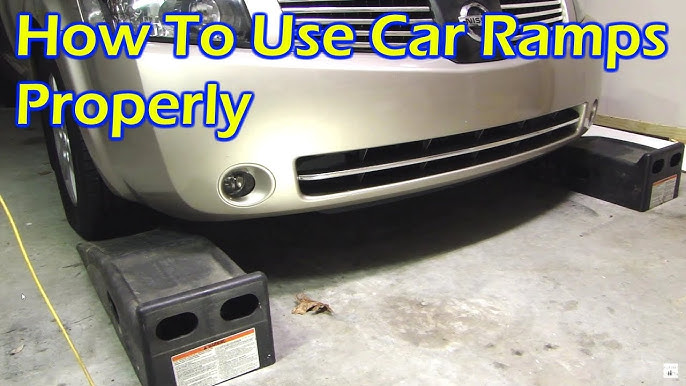Imagine being able to carry out essential car maintenance tasks without the hassle of heading to a mechanic every time. Picture the convenience and savings at your fingertips.
That’s exactly what using car ramps can offer you. If you’ve ever wondered how to safely and effectively use car ramps, you’re in the right place. Whether you need to perform an oil change or simply want to understand the process better, this guide will walk you through every step.
By the end of this article, you’ll feel confident and ready to take charge of your car maintenance needs. So, let’s dive in and unlock the secrets to mastering car ramps, ensuring your vehicle stays in top shape while you save both time and money.

Credit: www.youtube.com
How To Use Car Ramps Properly
Position the car ramps on a flat surface. Align them with your vehicle’s tires. Drive slowly onto the ramps until secure. Always use parking brake and wheel chocks for safety.
Using car ramps can make car maintenance easier and safer. But it’s crucial to use them correctly to ensure your safety and the car’s stability. Let’s dive into some essential tips for using car ramps properly. Choosing the Right Surface Selecting the proper surface is vital for stability and safety.
– Level ground: Ensure the surface is flat to prevent the car from rolling. – Hard surface: Use concrete or asphalt to support the car’s weight effectively. – Dry area: Avoid wet or slippery surfaces to maintain grip. Inspecting the Ramps Before using ramps, check their condition.
– No cracks: Inspect for any visible damage that could affect strength. – Clean surface: Remove any dirt or debris for a secure grip. – Weight capacity: Verify the ramps can support your car’s weight. Positioning the Ramps Correct placement is essential for safe usage.
Place the ramps in line with the car’s front wheels. Ensure they are centered and stable. This alignment helps in driving the car onto the ramps smoothly. Driving Onto the Ramps Driving up the ramps requires patience and care. – Slow speed: Drive up slowly to maintain control.
– Straight path: Keep the wheels aligned with the ramps. – Stop at the top: Once the car is on, stop gently. Securing the Car After positioning, ensure the car remains stable. – Handbrake: Engage the handbrake to prevent movement.
– Gear shift: Put the car in park or first gear. – Wheel chocks: Place chocks behind rear wheels for extra security.
How To Use Car Ramps For Oil Change
Position car ramps on a flat surface for stability. Drive the car slowly onto the ramps. Ensure the vehicle is secure before starting the oil change.
Changing your car’s oil can be straightforward if you know the steps. Car ramps simplify the process, letting you reach the oil pan easily. But using them correctly ensures both safety and efficiency. Choosing the Right Car Ramps Selecting the right ramps is crucial: – Weight capacity: Ensure ramps support your vehicle’s weight.
– Ramp angle: Opt for a gentle incline for low-clearance cars. – Material: Choose sturdy materials like steel or heavy-duty plastic. Positioning the Car Ramps Correct placement is key for safety: – Flat surface: Place ramps on a stable, level area.
– Align ramps: Position ramps directly in front of each front tire. – Distance: Ensure ramps are spaced evenly for both tires. Driving Onto the Ramps Approach with caution: Drive slowly onto the ramps. Maintain a steady speed. Avoid sudden acceleration.
Once the car is secure, engage the parking brake. Check the vehicle’s stability before proceeding. Preparing for the Oil Change Once the car is elevated, it’s time to prepare: – Gather tools: Have a wrench, oil filter, and new oil ready.
– Protect the area: Place a drip pan beneath the oil pan. – Safety check: Ensure the car is stable on the ramps. Changing the Oil Follow these simple steps: – Drain old oil: Unscrew the oil pan plug and let oil drain into the pan.
– Replace filter: Remove the old oil filter and install a new one. – Add new oil: Pour new oil into the engine, checking levels with the dipstick. Removing the Car from Ramps Final steps ensure safety: – Reverse slowly: Back off ramps with caution.
– Check surroundings: Ensure the area is clear before reversing. – Store ramps: Put ramps away for future use. Using car ramps for an oil change is straightforward when steps are followed. Safety first ensures a smooth process.

Credit: haynes.com
Conclusion
Mastering car ramp use ensures safe vehicle maintenance. Start with placement. Position ramps on a flat surface. Align them with your vehicle’s tires. Drive slowly onto the ramps. Secure the car by engaging the parking brake. For oil changes, ramps provide easy access.
Ensure you have the right tools. Always prioritize safety. Double-check ramp stability. Regularly inspect ramps for wear. This simple tool can make car maintenance easier. Remember, proper use is key. Stay safe while working on your vehicle. Maintain your car with confidence and care.
